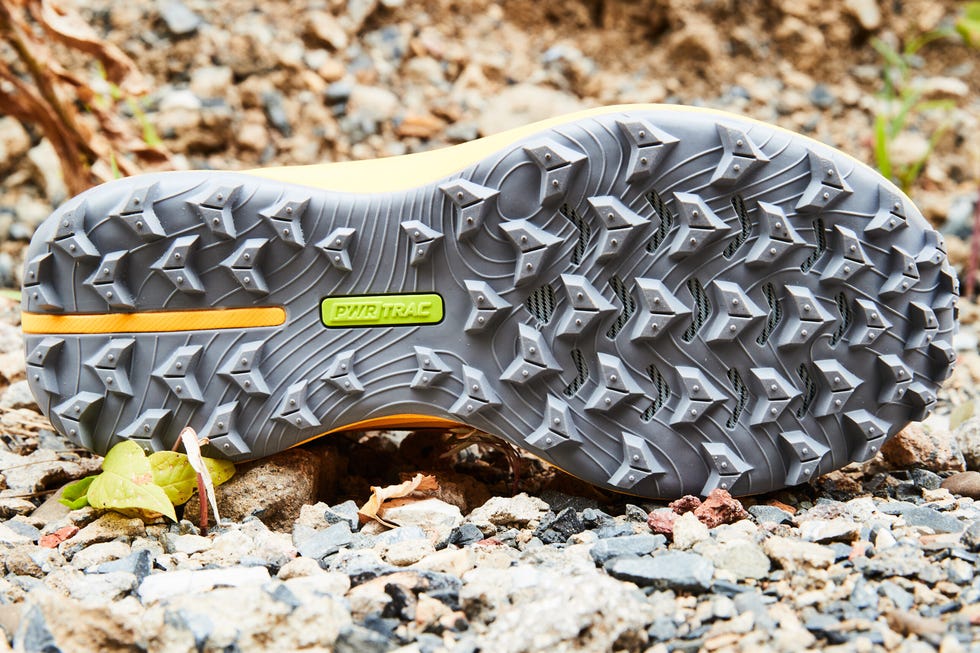But that doesnt mean they wont still love it: The Peregrine’s range of trail-ready features and responsive cushioning accommodate runs on soft, rocky, muddy, wet, and dry terrains. This is a go-to shoe for trails that have a little bit of everything.
- Slightly tacky Pwrtrac outsole grips slippery rocks and mud
- The 5 Best Folding Treadmills of 2025
- The Best New Shoes You Can Buy Now
Price: $130
Type: Trail
Weight: 9.5 oz (M), 8.0 oz (W)
Drop: 4 mm
Buy Men’s Buy Women’s More Images
Saucony’s Peregrine line has long been a speedy trail shoe that works well for many types of runners in a wide variety of conditions. It’s just as suited for newbies’ first footprints on a muddy trail as it is for shielding vert-chasers’ toes on rock-strewn singletrack. And it’s earned multiple awards from our team for its versatility—across terrains, foot shapes, and distances—at a price that didn’t break the bank. It still does all of those things well, though it underwent a big change: Saucony shaved off over an ounce compared to last year’s Peregrine.
Most of that weight savings comes from the upper and topsole. A more durable, sleek mesh keeps the same level of protection without the need for more layered overlays. Underfoot, Saucony peeled off the TPU bead-based topsole and instead used it for the sockliner. The midsole itself still uses less-responsive Pwrrun foam, but embedded in it is a new rock plate tuned to be slightly more flexible. On foot, it comes together mostly well. The more pliable rock plate keeps the shoe running smooth yet still protective, despite the thin stack height—the heel and forefoot measurements are down just half a millimeter each.
Is the Peregrine 12 Better Than the 11?
Runners seeking a fast and nimble shoe will love Saucony’s big revisions for the 12. It’s noticeably lighter, more flexible on toe off, and capable on wet technical terrain. The upper thins out quite a bit, too, reserving its protective welded overlays only for the areas you’ll really need them—mostly around the toebox and forefoot to shield against stubs. (Though more minimalist than ever, it hasn’t shown any durability issues over 100 miles of testing.) These updates now make the Peregrine 12 better suited for fast efforts, trail tempos, and racing.
However, longtime fans of the shoe might find their go-to trainer now feels a little sparse in the cushioning department. There’s still excellent protection underfoot, but it comes by the way of a pliable rock plate, instead of generous midsole foam. Many will want more cushioning—or at least softer cushioning—for runs in double-digit mileage. That’s not to say you can’t push this shoe to the ultra distance, as one of our wear-testers gladly did, below.
Post 50K Race Feedback
Rip C. | Tester since 2021
The Cut Up: Saucony Peregrine 11
Much nimbler and lighter than all the Peregrines before it
“The cushioning is moderate in amount and firmness, not marshmallowy soft. For me, it’s a welcome option for middle-to-long distances with ankle-biter rocks and steep descents. At first, I had some concerns about the looseness of the fit, but after their 50K maiden voyage, my toes were about as happy as they could be at that distance. The fit is wide and my toes do not pooch out over the sides of the platform like in most other bands I’ve worn. I covered about 13,000 feet of elevation gain during the testing period on mostly technical trails, smooth singletrack, grass, creek-crossings, and broken concrete. The outsole handled those conditions reasonably well, although I did still manage to slip in mud—not thick, shoe-sucking mud, but a variety of a thinner consistency. Loose dirt, wet leaves, and rocks posed no problem. Cosmetically, these shoes look pretty beat-up right now, but functionally, they’re broken-in and uncompromised.”
















